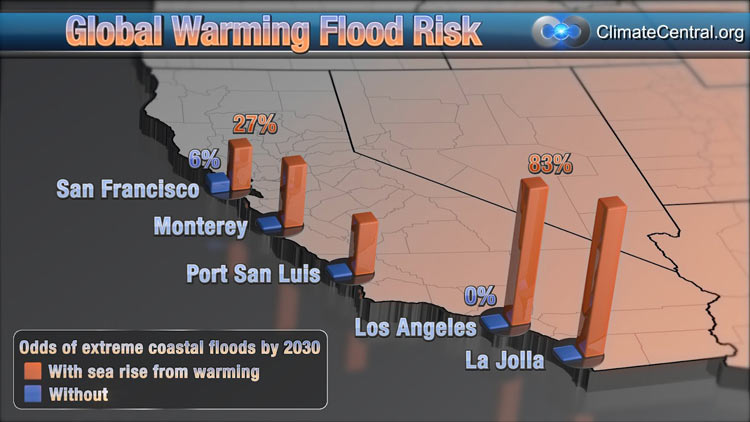Whatever you call it, it's time get our coastline ready for this "slow moving emergency."
 |
| Active bluff failures at Fletcher Cove, Solana Beach "Solanabeach-activeblufffailures" by Stickpen - Own work. Licensed under Public Domain via Wikimedia Commons |
Sea levels are rising in California as they are throughout the world. To date the rise has been measured in inches, but it will increase noticeably in our lifetimes. What we know and enjoy along the California coastline is going to look a lot different over the next twenty to eighty years.
The United States Environmental Protection Agency recently released a report, Climate Change in the United States: The Benefits of Global Action. As world leaders and scientists gravitate towards solutions aimed at capping world temperature increases at 2 degrees centigrade, the EPA report shows the benefits of action, including lessened risks to health, the environment, infrastructure and other sectors. However, the EPA report also shows that even with a world agreement, we're still going to see big impacts in the U.S. and we're going to have to deal with them.
One of the impacts is sea level rise. The chart on the left shows expected changes in global temperature with and without global action. The blue with-action line shows global temperature increases topping out at about 2 degrees centigrade above historic levels. The chart on the right shows sea level rising even with global action (blue line). The rise is expected to be about 3 feet by 2100 with action instead of about 5 to 6 feet with no action.
It's not just the rise in sea level that affects the coast. With rising sea levels comes much higher tides and strong storm surges. A relatively new term for the highest tides is "King Tides." We are seeing King Tides with more frequency and with greater impact.
 |
| San Francisco during a King Tide From King Tides Project Photographer daver6sf@yahoo.com |
The implications for the California coastline are huge and California climate leaders admit that not enough attention has been paid to adaptation. At a recent workshop on the adaptation for the utility sector, Ken Alex, Director of Governor Brown's Office of Planning and Research, described adaptation and resilience as having been the "stepchild" in the climate change discussions. He said we have to start paying much closer attention to adaptation now as we make infrastructure and other decisions.
Pacific Gas and Electric and other California utilities are looking at climate impacts ranging from sea-level rise to drought impacts on hydroelectric facilities to warmer weather impacts on air conditioner loads. PG&E is using an expectation of about a one foot rise in sea level by 2040 (the middle scenario below) as they decide how to handle their assets and infrastructure around the coast and bays of the state.
 |
| Source: PG&E presentation to CEC/PUC Adaptation Workshop 7/27/15 |
EPA, the State of California, private entities like PG&E and others are using projections like the ones above for planning purposes. The projections are generally based on mid-range analyses by the scientific community .. the rise could be a bit more or less, according to studies. There has been some recent analysis indicating that sea level rise could be SUBSTANTIALLY higher than these estimates. (Articles here and here).
The California Coastal Commission is finalizing a document to guide local coastal planning and development as sea level continues to rise. The current 287-page draft of the document, Sea Level Rise Policy Guidance, will be the subject of Commission action at their August 12 hearing in Chula Vista. The report calls for communities to take a sober and thorough look at impacts and start making tough decisions about addressing them. Communities from Del Mar to Arcata have recently taken steps to plan for sea level rise impacts. (UPDATE: The Coastal Commission finalized policy guidance is available here)
Responses to rising sea levels have traditionally fallen into three general categories, as pointed out in a recent report on "armoring" the coast from Stanford Law School: protection (e.g., armoring structures), accommodation (e.g. elevating structures above inundation levels), and retreat (e.g. prohibiting or relocating development and infrastructure). (Report here) The armoring option has included very controversial sea-walls, breakwaters and other structures in the past. Installing and maintaining the effectiveness of such structures will be increasingly challenging and expensive. In their recent special report on sea level rise impacts on the San Francisco Bay area, the San Francisco Public Press illustrated these options along with a fourth involving natural barriers, as illustrated here.
In many areas, it is likely we will have to abandon coastal facilities to higher waters by mid to late century. Some infrastructure, like airports, wastewater facilities and key transportation corridors may be able to forestall abandonment with some engineering solutions. However, it may be a losing battle and it may become inevitable that much of our key infrastructure will have to be abandoned and moved or somehow elevated above the water impact zone.
 |
| This map shows the odds of floods at least as high as historic once-a-century levels, occurring by 2030, based on Climate Central research. - See more here |
Sea level rise and related tide activity will impact bays and inland areas such as the Sacramento delta. As the San Francisco Public Press special report points out, there continues to be a development boom along the San Francisco Bay waterfront with limited thought to the long term impacts of sea level rise:
"Developers say they have engineering and financial solutions to deal with any reasonable future flooding risk. But critics, including climate scientists, urban planners and environmental activists, say the current wave of construction might leave taxpayers on the hook for enormously expensive emergency protections and repairs." San Francisco Public Press: Major SF Bayfront Developments Advance Despite Sea Rise WarningsThe California legislature is in a concurrent special session right now to look at transportation issues. It will be interesting to see how they link their transportation and climate change priorities.
Perhaps the best way to summarize the situation was provided last year in a report from the California Assembly Select Committee on Seal Level Rise and the California Economy:
"Sea-level rise has been called a slow-moving emergency. As a result, the future is not all doom and gloom since we have time on our side to prepare and plan for sea-level rise. Sea-level rise is not a surprise. We know it is happening and will only worsen. We must take advantage of the time we have to address this impending emergency now." (Sea Level Rise: A Slow Moving Emergency, August, 2014)

































